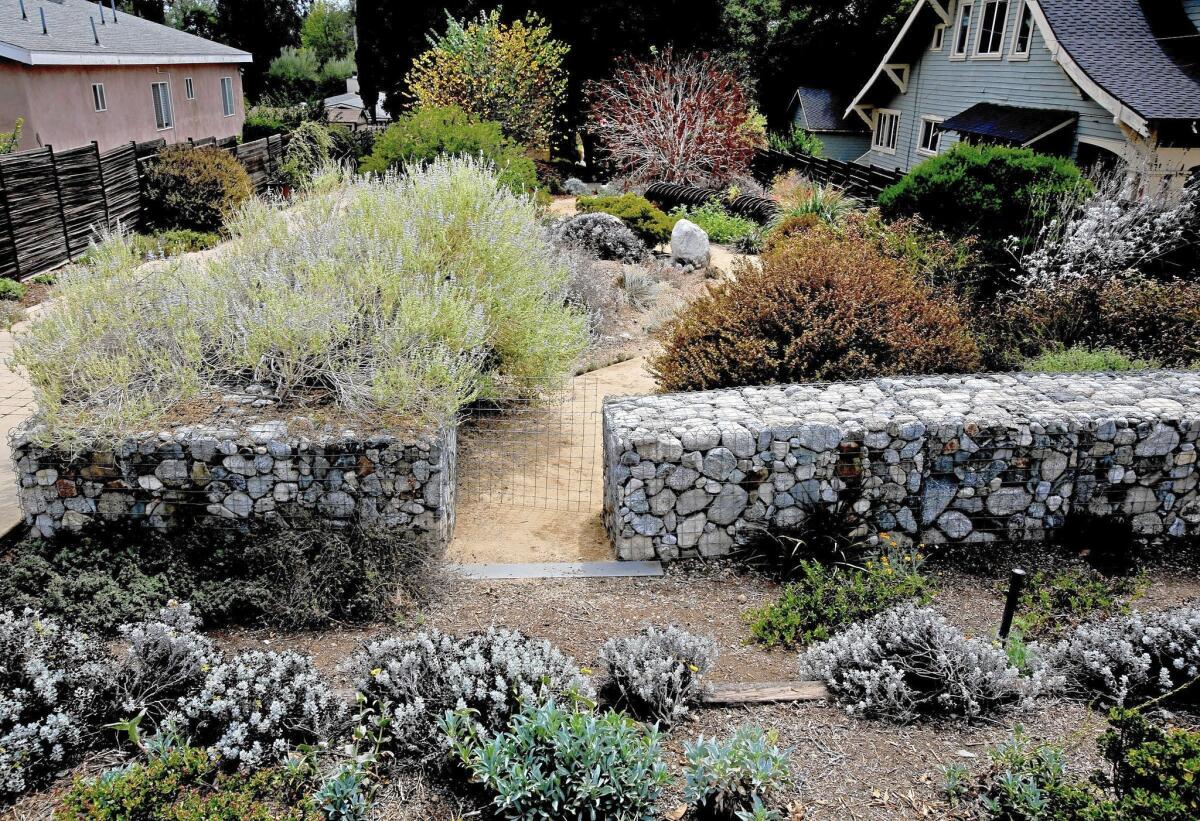Water-wise fall planting

- Share via
How to tackle fall planting in Southern California during the third straight year of drought and the diminishing likelihood of El Niño storms this winter? At the very least, Los Angeles gardening experts agree that planting in the fall is water-wise as new plants require less irrigation due to the cooler weather and will be well established by next summer. Here, we share their tips for fall:
Yvonne Savio
Master Gardener volunteer training program coordinator for Los Angeles County’s University of California Cooperative Extension, Alhambra
Fall is a wonderful time to plant because air temperatures are cooling. Plants are less stressed. Soil temperatures are still warm, so root systems establish well, and water applied to the garden stays within plant root zones for much longer than during hot weather. We need to water less often.
In terms of edibles, all of the usual suspects will provide food through our cool weather: beets, broccoli, cabbage, carrots, cauliflower, celery, chard, Chinese cabbage, collards, kales, kohlrabi, leek, lettuce, mustard, onions, peas, radish and spinach.
For herbs, try plants such as borage, chives, cilantro, dill, garlic, lavender, lemon verbena, lovage, marjoram, oregano, parsley, rosemary, sage, savory, sorrel and thyme.
Fall annuals could include alyssum, calendula, candytuft, coreopsis, gazania, hollyhocks, honesty, nasturtiums, California poppies and sweet peas.
Lili Singer
Horticulturist, garden writer, and director of special projects and adult education at the Theodore Payne Foundation, Sun Valley
This fall, I’ll be planting two of my favorite California natives: Santa Cruz Island buckwheat, a petite gray-leafed shrub with clusters of pink, good-bug-attracting flowers; and Eve Case coffeeberry, a shade-loving shrub that is a larval food plant of the pale swallowtail butterfly. For spring color, I’ll sow seed for native annual wildflowers, including Chinese houses, bird’s eye gilia and baby blue eyes. A few South African succulents and bulbs will also make their way into the garden.
To help conserve water, cover the soil between new transplants with a 3- to 4-inch layer of organic matter (leaves and bark) or gravel or decorative rock. No mulch should ever touch the trunk, stem or crown of a plant.
No plant is drought tolerant at planting, except a succulent. New transplants — like young children — need regular attention for the first year or two, as well as deep, thorough watering, whenever the top 3 to 4 inches of soil are dry.
Cassy Aoyagi
President, FormLA Landscaping Inc., Tujunga, and president, Theodore Payne Foundation
Fall is my favorite time, because natives especially show their appreciation of the cooler,shorter days.
Since rebates for lawn removal are the hot ticket, I’ll start with a fantastic plant to replace your thirsty lawn: Carex pansa (Dune Sedge) is one of the most versatile native grasses that we use. It can tolerate full sun and 50% shade as well as 50-80% less water. Its rich green and glossy blades emulate a traditional turf.
For color there are two nice plants I’d opt for: monkey flower and butterweed. Monkey flowers have just come out of their summer dormancy and are the first and fastest to respond to cooler days and will immediately burst into blooms. The dark green foliage can be accompanied by yellow, red or orange flowers, which makes a riot of color when mixed together.
Butterweed, planted in clusters together or mixed with perennials, has handsome silvery wispy leaves with contrasting and striking yellow daisy flowers. It tends to bloom on and off year round, but again is one of the first fall surprises coming out of a stressful, dry summer.
Edible options are important too. My go-to for fall is white sage, a plant that has numerous uses, including decoration (cut flowers) and cooking. After a summer of withstanding serious drought conditions, it spawns beautiful, silvery new growth toward the beginning of fall.
Judy Horton
Landscape designer at Judy M. Horton Garden Design, Los Angeles
When advising clients, I review high water use, and then look at short-and long-term solutions. Typical areas of high water use are the lawn, rose gardens, summer vegetables, and cut flower gardens. If we haven’t already eliminated or reduced our lawns, that is the place to start.
In my own garden only my sycamore tree is suffering. With no rain for a few years my soil is dry as dust 12 to 16 inches down. In April I realized that 30% of the tree, including my favorite low swoopy branch, was dead. Since then, soaker hoses have been deep watering it once a month. My mantra has always been that trees are the most important plants in any garden. Others can be replaced. But mature trees, in our lifetimes, are irreplaceable.
Some of my low water favorites for Southern California gardens include California poppies, agapanthus, clivia, peppermint-scented geranium, self-seeding nasturtiums and Corsican hellebore, an evergreen perennial.
Frank McDonough
Botanical information consultant, Los Angeles County Arboretum & Botanic Garden, Arcadia
I really like minimalist landscaping using river-rock swales running through decomposed granite.
Planted sparingly but for dramatic appeal, I like to plant agave, dasylirion, phormium and aloes of different colors and heights. I also like to see clumped succulents like aeoniums, sedums, crassulas and kalanchoes.
Spotted here and there it’s nice to see Canary Island natives such as sea lavendar and gold coin daisy and even some dwarf bougainvillea.
The nice thing about landscaping this way is that by paying attention to texture and leaf color you don’t have to rely on flowering for visual impact.







